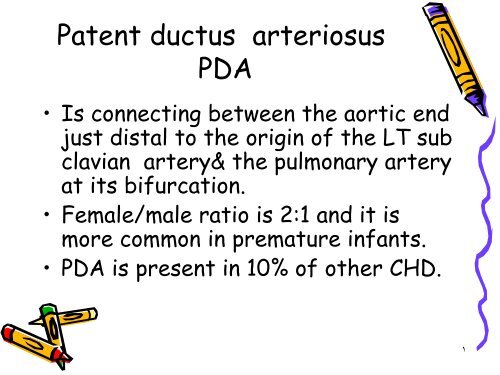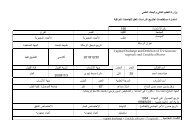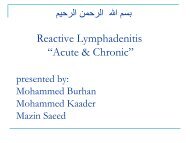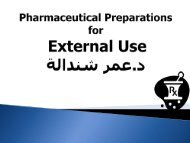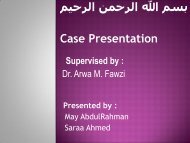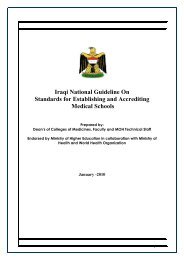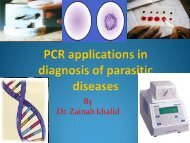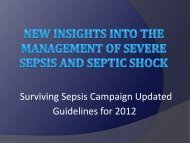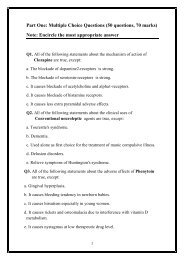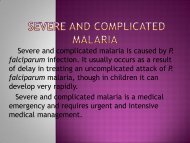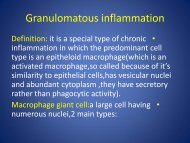Cyanotic congenital heart disease
Cyanotic congenital heart disease
Cyanotic congenital heart disease
Create successful ePaper yourself
Turn your PDF publications into a flip-book with our unique Google optimized e-Paper software.
Patent ductus arteriosusPDA• Is connecting between the aortic endjust distal to the origin of the LT subclavian artery& the pulmonary arteryat its bifurcation.• Female/male ratio is 2:1 and it ismore common in premature infants.• PDA is present in 10% of other CHD.1
PDA2
Pathophysiology of PDA• It is basically similar to VSD anddepend on the size of the defect.3
Clinical manifestation ofPDA• Symptoms : are basically similar to VSD.• Signs :• 1.Wide pulse pressure with bounding pulse.• 2.Prominant apical impulse.• 3.Systolic or continuous murmur in the 2 ndintercostal space radiating toward the clavicledown the LT lower sternal border or apex.• 4.Machinary murmur.• 5. Middiastolic murmur.4
Investigation of PDA• In small PDA:CXR&ECG is normal.• In large PDA:CXR will show prominent pulmonarya. with increase vascularity .• & cardiac size depend on the size of the shunt.• ECG : show increase LT atrial & LT ventriculardimensions.• Scanning of suprasternal notch will allowvisualization of the ductus & color Doppler&pulsed Doppler will show the turbulent bloodflow in the pulmonary a. .5
Prognosis of PDA• 1.Spontaneous closure after infancyis rare.• 2.cardiac failure occur in large duct.• 3.infective endocarditis .• 4.Eisenmenger syndrome• 5.Pulmonary hypertension.6
Treatment of PDA• Surgical closure fatality rate is
Differential diagnosis• 1.venous hum.• 2.Aortico pulmonary window defect.• 3.truncus arteriosus .• 4.Coronary arteriovenous fistula.8
Coarctation of aorta• Means constriction of the aorta atany area from the aortic arch to theiliac bifurcation most commonly justbelow the origin of the LT subclaviana. in 98% of cases.• Male Female ratio is 2:1.9
Clinical manifestation• 1.Mostly asymptomatic.• 2.The classical sign of coarctation is thedisparity in pulsation &Blood pressure of the arms& legs they are absent in 40% of cases ,the radial&femoral pulse should be examined simultaneously.• 3.B.P in upper limbs is higher than lower limbs.• 4.Leg pain &weakness in children & adolescents.10
Investigations ofcoarctation of aorta• CXR : show the effect of hypertension onthe <strong>heart</strong> &the effect of the collateralson the lower border of the ribs withcardiomegally & LT ventricularenlargement.• ECG:LT ventricular hypertrophy• Echo cardiography : by 2dimensional echo& color Doppler .11
Treatment ofcoarctation• 1.Treatment of congestive <strong>heart</strong>failure.• 2.Surgical repair.12
<strong>Cyanotic</strong><strong>congenital</strong> <strong>heart</strong> <strong>disease</strong><strong>Cyanotic</strong> CHD1.Lesions associated with decreasedpulmonary blood flow13
Tetra logy of fallot• Tof is a common cyanotic CHD ,itconsist of the following:• 1.Pulmonary stenosis PS• 2.Right ventricular hyper trophy RVH• 3.Ventricular septal defect VSD• 4.Aorta overriding the interventricular septum.14
Patho physiology of TOF• Systemic venous blood return to the RT atrium&RT ventricle. During systole in the presence ofPS blood is shunted across the VSD in to theaorta [RT to LT ] shunt ,so pulmonary blood flowmay be by bronchial collateral circulation ,or innewborn baby by PDA.• The degree of intra cardiac shunting is thefunction of outflow resistance which include:• 1.Pulmonary resistance.• 2.Systemic arteriolar resistance.15
TOF16
Clinical manifestation ofTOF• Symptoms:• 1.Cyanosis usually start few monthes afterbirth late in the first year.• 2.Dyspnoea on exertion.• 3.Growth failure.• 4.Paroxysmal hyper cyanotic attacks[Hypoxic ,Blue ,tet] spells usually in thefirst 2 years of life with increase cyanosis,gasping respiration.17
TOFSigns• 1.Central cyanosis &digital clubbing.• 2.Pulse is usually normal.• 3.The LT anterior hemi thorax may bulge anteriorly.• 4.Substernal RT ventricular impulse & systolic thrill alongthe LT sternal border in the third & forth spaces.• 5.Soft S2 with loud harsh ejection systolic murmur at theupper sternal border or it may be holosystolic murmurtoward the lower sternal border.• 6.During spells the murmur become softer.• 7.There may be continuous murmur of the collaterals.18
TOFInvestigations• CXR :the <strong>heart</strong> is not enlarged ,concavityis usually found in the area occupied bymain pulmonary a. With boot shape <strong>heart</strong>& Oligaemic lung fields .• ECG :will show RT axis deviation & RTventricular hypertrophy ,P wave is tall &peaked.• ECHO: will establish the diagnosis.19
CXR of TOF20
TOFComplications• 1.Cerebrovascular accident due tothrombosis secondary to dehydration& polycythemia in the first two yearsof life .• Brain abscess after 2 years .• SBE.21
TOFTreatment• 1.Palliative surgery by Blalock Tausig shunt[Pulmonary to Systemic artery shunt].• 2.Total corrective surgery under cardio pulmonarybypass .• 3.Treatment of complications like Hypoxic [tet]spells by:• 1.Position• 2.Oxygen• 3.Morphine S.C 0.2mg/kg .• 4.Propranolol 0.1mg/kg I.V .22
Tricuspid Atresia• There is no outlet from RT atrium to RT ventricleso LT ventricle push blood to RT ventricle via VSD& severity of cyanosis depend on size of VSD &severity of pulmonary stenosis .• Clinically : cyanosis present since birth, withincrease LT ventricular impulse, with holosystolicmurmur on LT lower sternal border, with single S2,associated with easy fatigability ,exertionaldyspnoea &occasional hypoxic episodes ,23
Diagnosis & treatment ofTricuspid Atresia• CXR :Oligaemic lung.• ECG: LT axis deviation < ventricularhypertrophy .• ECHO : 2 D echo will diagnose the condition.• Treatment is by:• 1.Blalock-Taussig procedure.• 2.Modified Fontan procedure by anastomosing RTatrium to the pulmonary a. Done at 1.5_3 years ofage .24
Ebstein anomaly• There is downward displacement of anabnormal tricuspid valve into the RTventricle with remaining poorly functioningRT ventricle which fail to pump blood tothe pulmonary a. Producing functionalpulmonary atresia so there will be RTatrial to LT atrial shunt through foramenovale to produce cyanosis.25
2.<strong>Cyanotic</strong> CHD with increasepulmonary blood flowTransposition of great arteriesTGA• TGA is common CHD form about 5%of all CHD.• In this anomaly the aorta arisesfrom RT ventricle & pulmonary a.Arises from LT ventricle sounsaturated blood will be pumpedagain via aorta to all the body sosurvival depend on presence offoramen ovale & ductus arteriosus& 50% of patients will have VSD ,itis more common in infants ofdiabetic mothers & in males 3:1female.26
TGA with intact septumClinical manifestation• Cyanosis & tachypnea are recognized within thefirst hours or days after birth if not treatedmost patient will not survive the neonatal period,hypoxia is severe &<strong>heart</strong> failure is less common itis a medical emergency.• O \E:1.central cyanosis since birth .• 2.normal apex beat or there may be parasternalheave .• 3.2 nd <strong>heart</strong> sound is usually single &loud .• 4.murmurs may be absent or systolic murmur atthe mid left sternal border .27
Investigation&Treatment of TGA• CXR :mild Cardiomegally ,narrow mediastinum ,increasepulmonary blood flow .• ECG :show normal neonatal RT dominant pattern.• The arterial PO2 is low even after 100% Oxygen saturation[hypoxia test] .• ECHO :will confirm the diagnosis .• Cardiac catheterization .• Treatment :when TGA is expected the patient infused withProstaglandin E1 immediately to maintain the patency ofductus arteriosus & to improve oxygenation ,the dose is[0.05-20 microgram\Kg\minute] with keeping the patientworm to prevent hypothermia & acidosis also to correcthypoglycemia .28
CXR of TGA29
TGA Treatment• In patients with severe hypoxia in spite ofprostaglandin will need [Rashkind BalloonAtrial Septostomy] .• The atrial switch [Jatene procedure] isthe surgical treatment of choice ,can beperformed in the first 2 weeks of life .30
TGA with large VSD• Will be manifested by history of <strong>heart</strong>failure & cyanosis is subtle or presentlater & the murmur is holosystolic murmur.• CXR :Cardiomegally ,narrow mediastinum&increase pulmonary vascularity.• ECHO :will confirm the diagnosis .• Treatment :Arterial switch procedure+VSD closure .31
TGA with VSD•32


